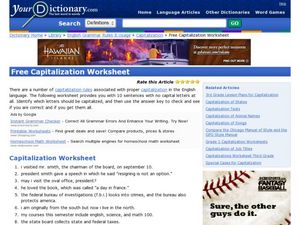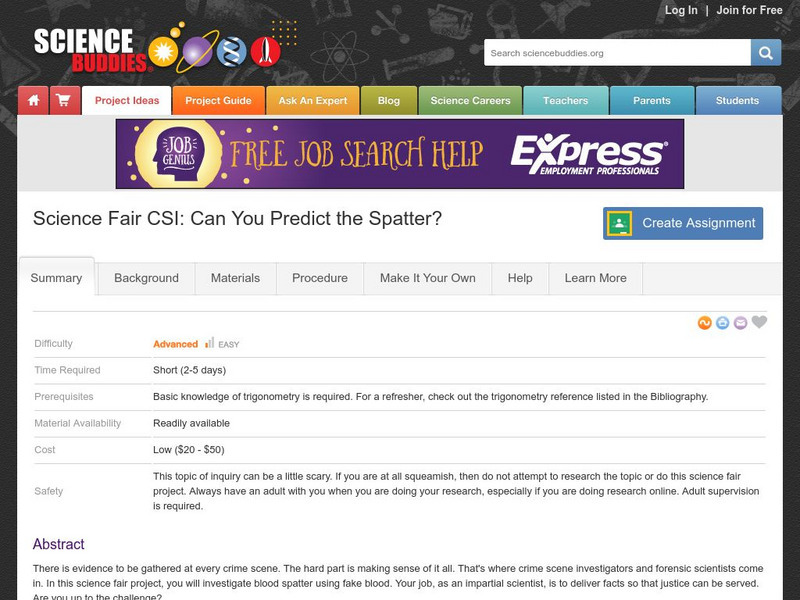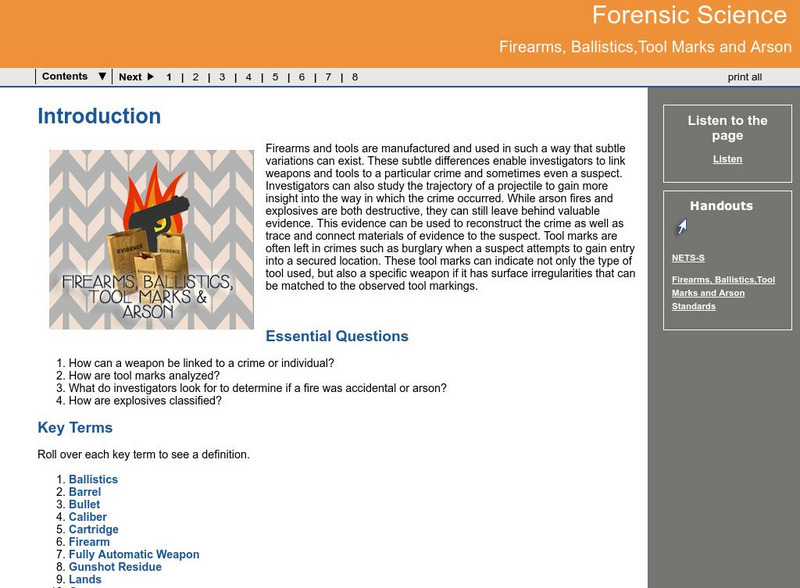Curated OER
DNA Fingerprinting
Young scholars experiment with chromatography as a technique which is similar to electrophoresis that scientists use to identify DNA samples.
Curated OER
Blood, I Presume?
Students explain the value of blood in trials. In this DNA lesson students work together to collect and share information and ideas that they come up with after learning how to distinguish blood from other stains.
Curated OER
Where in the World is Cynthia San Francisco? A weather-related challenge
Students investigate concepts of weather using a guided, essential question. They collect data from satellite weather images and create models to track the progress of weather changes.
Curated OER
Create A DNA Fingerprint
Young scholars engage in a lesson that is about the DNA molecule and focuses upon the sequencing of proteins to identify individuals. They conduct research using a variety of resources and then complete the activities included in the 3...
Curated OER
Dig Magazine Archeology Quiz #106
In this Dig Magazine archeology quiz, students answer 12 multiple choice questions complementing the October 2009 issue. Page contains answer and additional resources link.
Curated OER
Jack the Ripper: Limitations of the Police Force
In this British law enforcement worksheet, students learn why police had such difficulty tracking down and capturing 'Jack the Ripper' in the Whitechapel murders of 1888. Three questions are listed for students to complete.
Curated OER
Tech: Medical Forensics
High schoolers explore what it takes to be a forensic scientist or pathologist. They view a PowerPoint, discuss what education and skills are needed to succeed as a pathologist. They play a game to test their observation skills, a skill...
Texas Instruments
Vandalism 101
Learners explore logic and use Geometer’s Sketchpad and patterns of logic to solve a puzzle.
Curated OER
Lewis and Clark in Columbia River Country
Students interpret historical evidence presented in primary and secondary resources. In this research skills lesson, students research the death of Meriwether Lewis using forensic evidence presented in primary...
Love to Know
Free Capitalization Worksheet
Not really a worksheet, but rather, a website that has 10 sentences void of all capital letters. Copy these onto a handout or project them on the wall for your class to use as practice. Answers follow, along with an explanation as to why...
TED Talks
Ted: Ted Ed: Early Forensics and Crime Solving Chemists
In a CSI age, we take forensic science for granted. New York did not have a medical examiner or forensic toxicologist until 1918, whose eventual arrival changed the landscape of crime investigation forever. Deborah Blum prompts the TED...
Georgia Department of Education
Ga Virtual Learning: Crime Science Investigation
In this comprehensive interactive tutorial you will learn the basic components of a crime scene investigation and how they are implemented. You will also learn various evidence collecting techniques, as well as how to properly document...
Science Buddies
Science Buddies: Science Fair Csi: Can You Predict the Spatter?
There is evidence to be gathered at every crime scene. The hard part is making sense of it all. That's where crime scene investigators and forensic scientists come in. In this science fair project, you will investigate blood spatter...
Georgia Department of Education
Ga Virtual Learning: Forensic Science: Analysis of Hair, Fiber and Botanical Mtl
This comprehensive interactive tutorial explores forensic science, particularly within the area of hair analysis. Investigate the parts of a hair and how it grows. Learn how is hair evidence is collected and analyzed and what different...
Science Struck
Science Struck: Locard's Exchange Principle in Forensic Science
'This resource describes some of the history of forensic science and what Locard's Exchange Principle is and how it is applied. Discusses the different types of trace evidence that investigators look for and some drawbacks of Locard's...
Virtual Museum of Canada
Virtual Museum of Canada: Virtual Exhibit on Forensic Science
Discover the components of forensic science. There is also a link to a simulation in which you can apply your skills to solve a crime.
Other
Science Spot: Forensic Science Lesson Plans
Huge collection of teacher-created lessons, activities, PowerPoint presentations, and worksheets for classes in forensic science.
Mocomi & Anibrain Digital Technologies
Mocomi: What Is Forensic Science?
Defines Forensic Science and describes what Forensic scientists do.
Other
Teachers First: Lessons: Who Did It? Forensics to Hone Science and Lab Skills
Comprehensive twenty-activity unit, complete with a WebQuest and assessment materials, designed to introduce forensic science to middle schoolers in grades 6, 7, and 8.
Cyberbee
Cyberbee: Who Dunnit?
If you are a crime scene investigation (CSI) fan, then you will love this site! You get to be the detective by examining the evidence, viewing the crime scene, dusting for fingerprints, interviewing the suspects, and solving the crime.
Georgia Department of Education
Ga Virtual Learning: Forensic Properties of Glass and Soil Evidence
In this comprehensive interactive tutorial you will investigate the area of forensic science and how the various types of evidence differ. Learn what types of crimes involve glass and soil and what ways these types of evidence are...
Georgia Department of Education
Ga Virtual Learning: Forensic Serology
In what ways does serological evidence help solve a crime? This comprehensive learning tutorial explores what information can be determined from a drop of blood and how blood typing is done. Learn what information we get from blood stain...
Georgia Department of Education
Ga Virtual Learning: Firearms, Ballistics,tool Marks and Arson
In this interactive tutorial you will learn how firearms and tools are manufactured and used in such a way that subtle variations can exist. These subtle differences enable investigators to link weapons and tools to a particular crime...
Science Education Resource Center at Carleton College
Serc: Chromatography: Who Wrote the Note?
Students investigate who stole the class pet by testing the chromatograph of different markers as a way to find the evidence that points to the perpetrator.

























